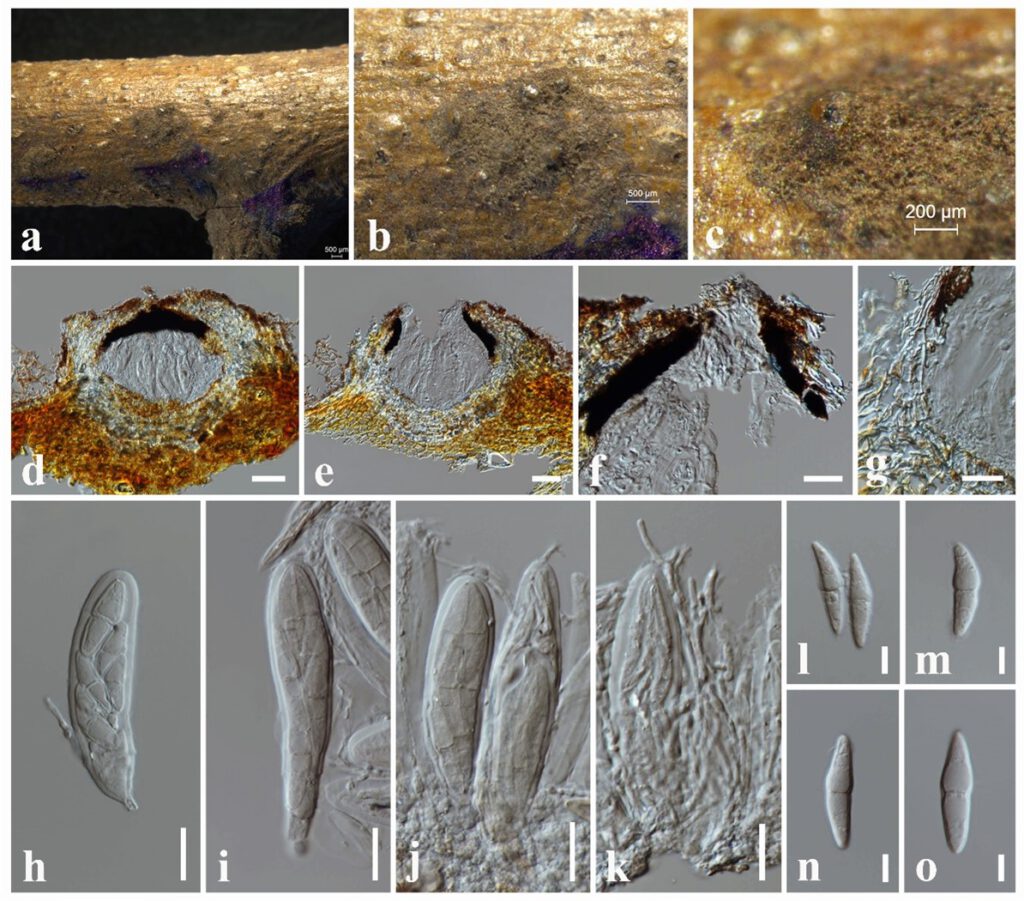Hermatomyces anomianthi N.I. de Silva, Lumyong & K.D. Hyde, sp. nov.
MycoBank number: MB 559517; Index Fungorum number: IF 559517; Facesoffungi number: FoF 10715; Fig. 6.16
Etymology: Name reflects the host genus Anomianthus, from which the new species was isolated.
Holotype: MFLU 21-0221
Saprobic on dead twigs attached to Anomianthus dulcis. Sexual morph: Ascomata 150–220 μm high × 200–230 μm diam. ( = 180 × 220 µm, n = 10), dark brown to black, immersed, slightly erumpent, solitary to aggregated, scattered, appearing as black spots, with a poorly developed basal layer. Ostiole 40–70 μm wide, central. Peridium 15–25 μm wide, hyaline to light brown, comprising of thick-walled cells of textura angularis fusing and indistinguishable from the host tissues. Hamathecium comprising 1.4–2.5 μm wide, cylindrical to filiform, septate, pseudoparaphyses. Asci 75–110 × 19–24 μm ( = 100 × 21 µm, n = 20), 8-spored, bitunicate, cylindrical short, straight or slightly curved pedicellate. Ascospores 35–49 × 8–12 μm ( = 40 × 10 µm, n = 30), hyaline, broadly fusiform, 1-septate, constricted at the septum, widest at the centre and tapering towards ends, granular. Asexual morph: Undetermined.
Culture characteristics – Colonies on PDA reaching 20 mm diameter after 1 weeks at 25°C, colonies from above: circular, margin entire, dense, surface smooth, velvety appearance, cream at the margin, pale brown in the centre; reverse: brown at the margin, dark brown in the centre.
Material examined – THAILAND, Chiang Rai Province, dead twigs attached to host plant of Anomianthus dulcis (Annonaceae), 4 April 2019, N. I. de Silva, AND23 (MFLU 21-0221, holotype), living culture, MFLUCC 21-0202.
Notes – Our new collection (MFLUCC 21-0202) groups with ex-type strain of Hermatomyces nabanheensis (KUMCC 16-0149) which was isolated from on dead leaves of Pandanus sp. in China (Hyde et al. 2017) with 100% ML statistical support. A pairwise comparison of ITS sequence data between the new collection (MFLUCC 21-0202) and Hermatomyces nabanheensis (KUMCC 16-0149) indicates 20 base pair (10%) differences across 500 nucleotides. A pairwise comparison of tef1 sequence data between the new isolate (MFLUCC 21-0202) and Hermatomyces nabanheensis indicates 29 base pair (3.11%) differences across 930 nucleotides. Since our new collection is sexual morph, we are unable to compare morphological difference with the type Hermatomyces nabanheensis. We introduced our collection as the first sexual morph record of Hermatomyces and here we introduced Hermatomyces anomiae as a novel species.

Figure 6.16 Hermatomyces anomianthi (MFLU 21-0221, holotype). A The specimen. b, c Appearance of ascomata on substrate. d, e Vertical sections through ascoma. f Apex of ascomata. g Peridium. h–j Asci. k Pseudoparaphyses with asci. l–o Ascospores. Scale bars: b = 500 μm, c = 200 μm, d–k = 20 μm, l–o = 10 μm.
